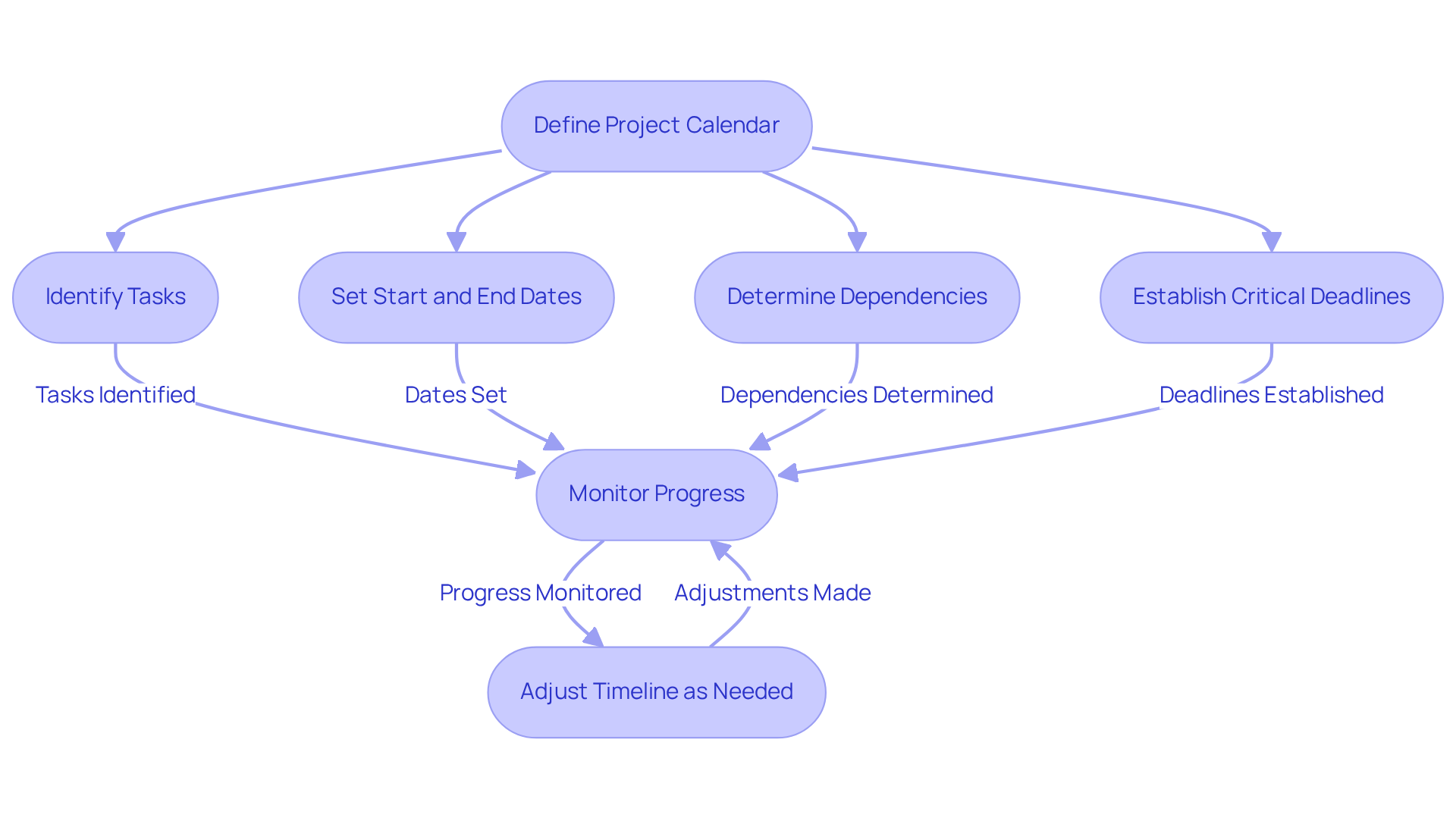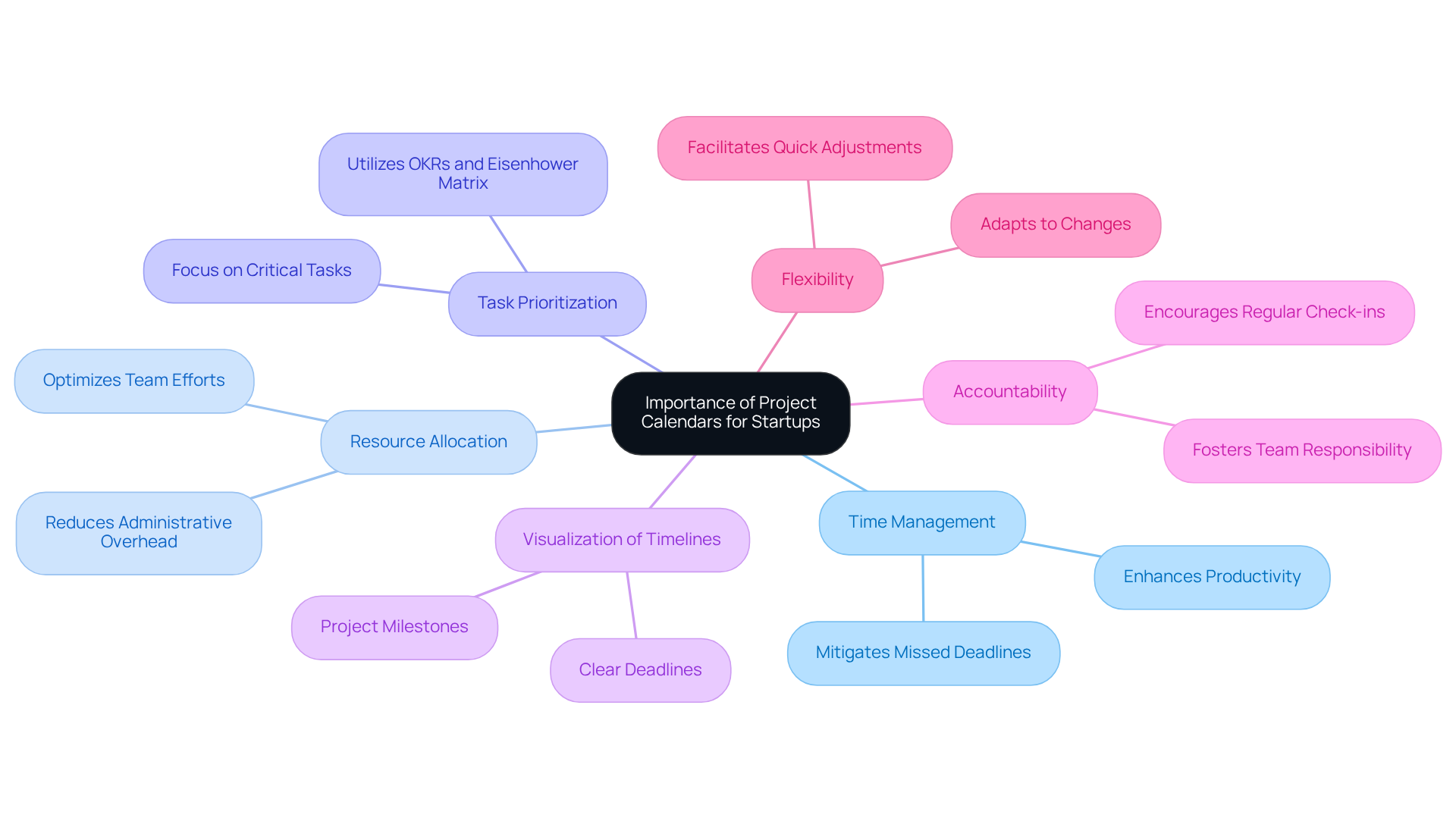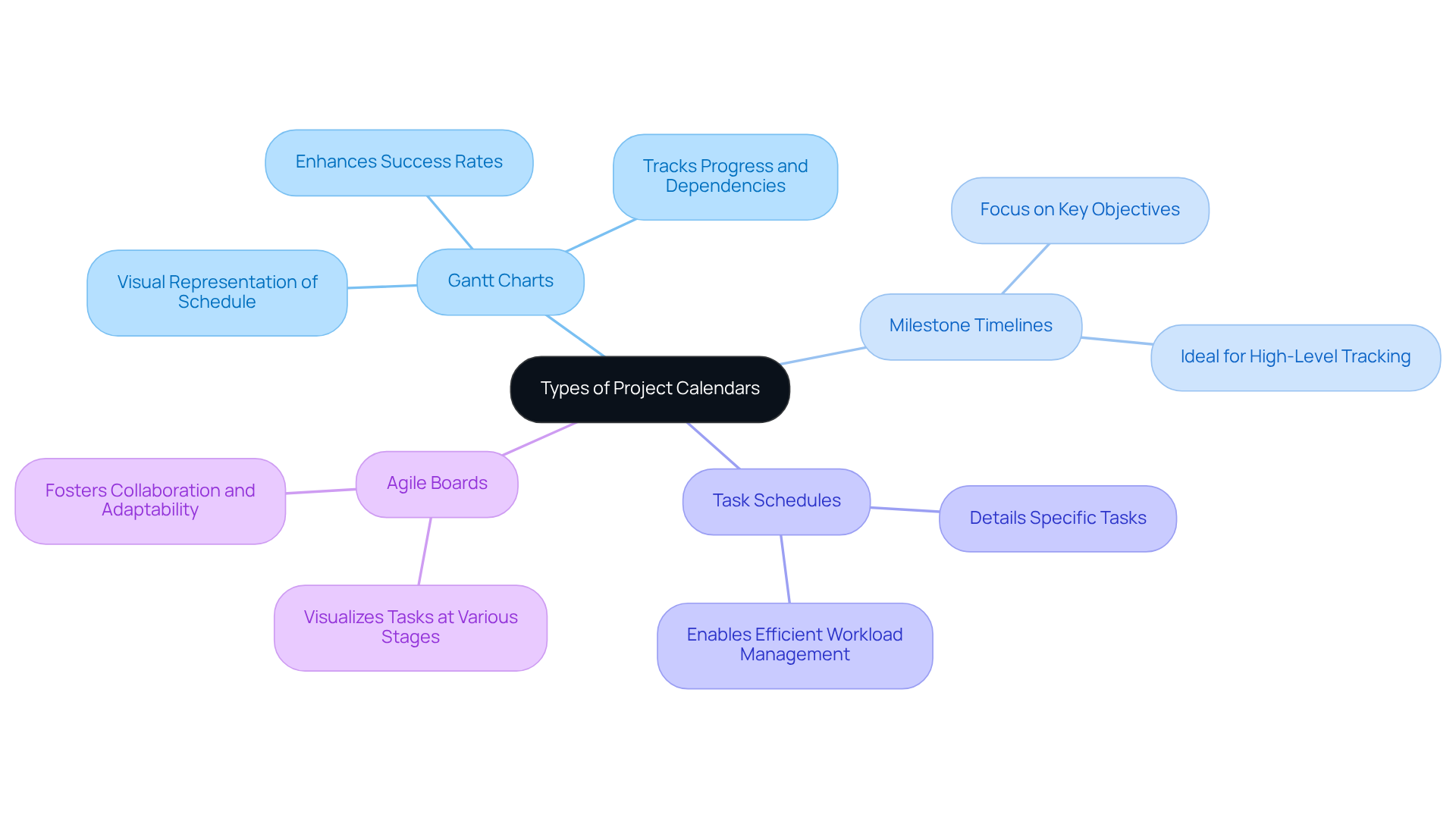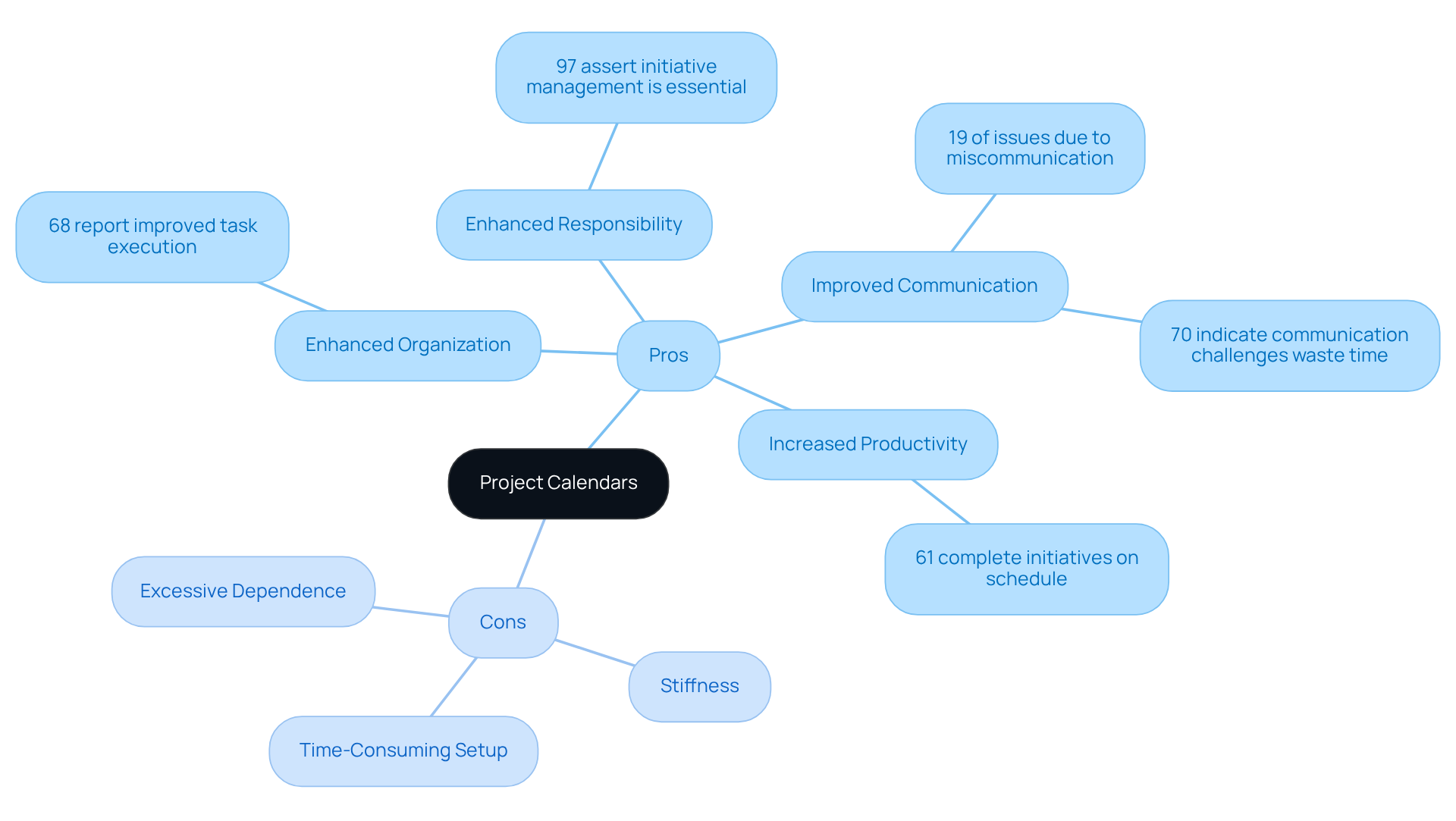Overview
The article underscores the critical role of project calendars in bolstering organization, accountability, and communication within teams, especially for startups grappling with tight deadlines and limited resources. It presents compelling evidence that structured planning tools significantly enhance task execution and overall project success rates. Furthermore, it elaborates on various types of project calendars, detailing their specific advantages.
How can startups leverage these tools to navigate their unique challenges? By implementing effective project calendars, founders can streamline their processes and improve outcomes, ensuring they stay on track amidst the pressures of growth.
Introduction
A project calendar transcends being merely a timeline; it serves as a pivotal instrument that can dictate the success of an initiative. By offering a structured overview of tasks, deadlines, and milestones, it empowers teams to elevate their productivity and optimize their workflows. Yet, a critical question arises: how can various types of project calendars be effectively employed to tackle the distinctive challenges encountered by startups? Delving into the significance, advantages, and diverse forms of project calendars not only underscores their essential role in project management but also highlights the potential pitfalls that teams must navigate to secure successful outcomes.
Define Project Calendar
A project calendar is an essential visual aid that delineates the timeline and key milestones of an endeavor, specifying when particular tasks and activities are arranged. It serves as a guide for overseeing tasks, allowing groups to monitor advancement using the project calendar, distribute resources efficiently, and guarantee timelines are achieved. Timelines can be established using different tools, such as digital planning software, spreadsheets, or even physical organizers. Typically, a project calendar includes start and end dates for tasks, dependencies between activities, and critical deadlines, offering a comprehensive view of the timeline.
Why is planning timelines so crucial? Recent data shows that organizations employing efficient task oversight methods, including well-organized schedules, achieve a 92% success rate in fulfilling objectives. With 62% of organizations expecting a rise in workload, the demand for effective tools for overseeing tasks becomes increasingly essential. In startups, where flexibility and quick execution are paramount, establishing a project calendar can optimize workflows and improve overall productivity.
Consider this: numerous task coordination tools, including Casy, now incorporate scheduling features that enable teams to see their assignments and due dates in real-time. This promotes improved collaboration and communication. Such integration not only assists in planning the project calendar but also significantly reduces the chance of missed deadlines and scope creep, which impacts 40% of initiatives in organizations lacking soft skills. Furthermore, 77% of high-achieving initiatives employ software tools, underscoring the significance of timelines as a component of successful planning techniques. Thus, a project calendar is not merely a planning tool; it is a crucial element of efficient oversight that fosters effectiveness and achievement.

Importance of Project Calendars for Startups
For startups, scheduling tools are essential instruments that enhance time management and resource allocation. They empower teams to prioritize tasks, visualize timelines, and uphold accountability among members. By offering a comprehensive overview of deadlines and milestones, the project calendar significantly mitigates the risks of missed deadlines and miscommunication—common challenges in startup environments.
Did you know that startups lacking organized timelines face a higher frequency of missed deadlines? This can stifle growth and innovation. Moreover, the project calendar facilitates swift adjustments to changes, ensuring that tasks stay on track despite unforeseen occurrences. This flexibility is vital for startups, which often contend with tight deadlines and limited resources.
Expert insights underscore that utilizing planning tools, including a project calendar and efficient schedules, can lead to improved productivity and organized workflows.
Take Casy, for instance; it automatically compiles information from discussions to generate tasks and establish deadlines. This illustrates how schedules can be enhanced through automation, ultimately fostering a more organized and efficient operational structure.

Types of Project Calendars
There are several types of project calendars for initiatives, each serving distinct purposes and tailored to various management styles. Common types include:
- Gantt Charts: These bar charts visually represent the project schedule over time, illustrating task durations and dependencies. They are particularly effective for tracking progress and identifying potential bottlenecks. Research indicates that initiatives employing Gantt charts significantly enhance their success rates, remaining on schedule and within budget more efficiently.
- Milestone Timelines: Focused on key objectives, these timelines highlight important events or deadlines, making them ideal for high-level tracking.
- Task Schedules: These schedules detail specific tasks and their due dates, enabling team members to manage their workloads efficiently.
- Agile Boards: Primarily used in Agile management, these boards visualize tasks at various stages of completion, fostering collaboration and adaptability.
Each type of project calendar possesses unique advantages and can be selected based on the specific requirements of the task and the group's workflow. Given that 25% of supervisors perceive their business group as nearly 'always out of sync,' effective scheduling is crucial in addressing communication gaps within teams.

Pros and Cons of Project Calendars
Project calendars present a variety of advantages and disadvantages that teams must thoroughly assess:
- Enhanced Organization: Project calendars create a structured timeline for tasks, allowing teams to maintain clarity and order in their workflows. This organization is crucial, as 68% of entities report improved task execution when utilizing structured planning tools.
- Enhanced Responsibility: By clearly assigning deadlines and roles, schedules foster a sense of accountability among team members. This accountability is vital, with 97% of organizations asserting that initiative management is essential to business performance.
- Improved Communication: Serving as a central reference point, calendars reduce the likelihood of miscommunication, a frequent cause of failures accounting for 19% of issues. Clear communication channels are imperative for successful outcomes, especially since 70% of professionals indicate that communication challenges have led to wasted time.
- Increased Productivity: With a comprehensive overview of tasks and deadlines, teams can prioritize effectively, concentrating on high-impact activities. Organizations that employ management tools report completing 61% of their initiatives on schedule, underscoring the productivity benefits of organized planning.
Nonetheless, notable challenges exist:
- Time-Consuming Setup: Establishing and maintaining a project calendar can be labor-intensive, particularly for complex projects. This initial time investment may deter teams from fully leveraging this tool.
- Stiffness: Some teams might perceive schedules as overly rigid, potentially hindering their ability to adapt quickly to changes. Flexibility is often necessary in dynamic project environments.
- Excessive Dependence: Teams may become overly reliant on schedules, which could stifle creativity and adaptability in task execution. Striking a balance between structured planning and adaptive strategies is essential for fostering innovation.
As David Miller wisely observes, "It is the methods employed by leaders that either create or ruin the organization." By comprehensively understanding these pros and cons, teams can effectively harness project calendars, while remaining cognizant of their limitations, ultimately enhancing their project management practices.

Conclusion
A project calendar is an indispensable tool that not only outlines timelines and milestones but also enhances task management and team collaboration. By providing a clear framework for scheduling tasks, project calendars help ensure that organizations meet their objectives efficiently and effectively. This structured approach is especially crucial for startups, where agility and time management can significantly impact growth and innovation.
Throughout this article, we have explored various aspects of project calendars, including their importance in improving productivity, resource allocation, and communication within teams. Different types of project calendars, such as Gantt charts and milestone timelines, cater to specific project needs, allowing teams to choose the most suitable format for their workflows. Furthermore, the pros and cons of utilizing project calendars highlight the necessity of balancing structured planning with the flexibility required in dynamic project environments.
Ultimately, the significance of project calendars in project management cannot be overstated. They serve as essential tools for enhancing organization, accountability, and communication among team members. Embracing the use of project calendars can lead to improved project outcomes and increased success rates, particularly for startups navigating the complexities of growth. By prioritizing effective scheduling and leveraging the right tools, teams can position themselves for success in their endeavors.
Frequently Asked Questions
What is a project calendar?
A project calendar is a visual aid that outlines the timeline and key milestones of a project, specifying when tasks and activities are scheduled. It helps teams monitor progress, allocate resources efficiently, and ensure deadlines are met.
Why are timelines important in project management?
Timelines are crucial because organizations that use effective task oversight methods, including well-organized schedules, achieve a 92% success rate in meeting objectives. With increasing workloads, effective tools for managing tasks become essential.
What tools can be used to establish a project calendar?
Timelines can be created using various tools such as digital planning software, spreadsheets, or physical organizers.
What information is typically included in a project calendar?
A project calendar typically includes start and end dates for tasks, dependencies between activities, and critical deadlines, providing a comprehensive view of the project timeline.
How does a project calendar impact productivity in startups?
In startups, where flexibility and quick execution are key, a project calendar can optimize workflows and enhance overall productivity.
What role do task coordination tools play in project planning?
Task coordination tools, like Casy, often include scheduling features that allow teams to view assignments and due dates in real-time, improving collaboration and communication while reducing the likelihood of missed deadlines.
What percentage of initiatives are affected by scope creep due to a lack of soft skills?
Scope creep impacts 40% of initiatives in organizations that lack soft skills.
How significant are software tools in achieving project success?
77% of high-achieving initiatives utilize software tools, highlighting the importance of timelines in successful planning techniques.




